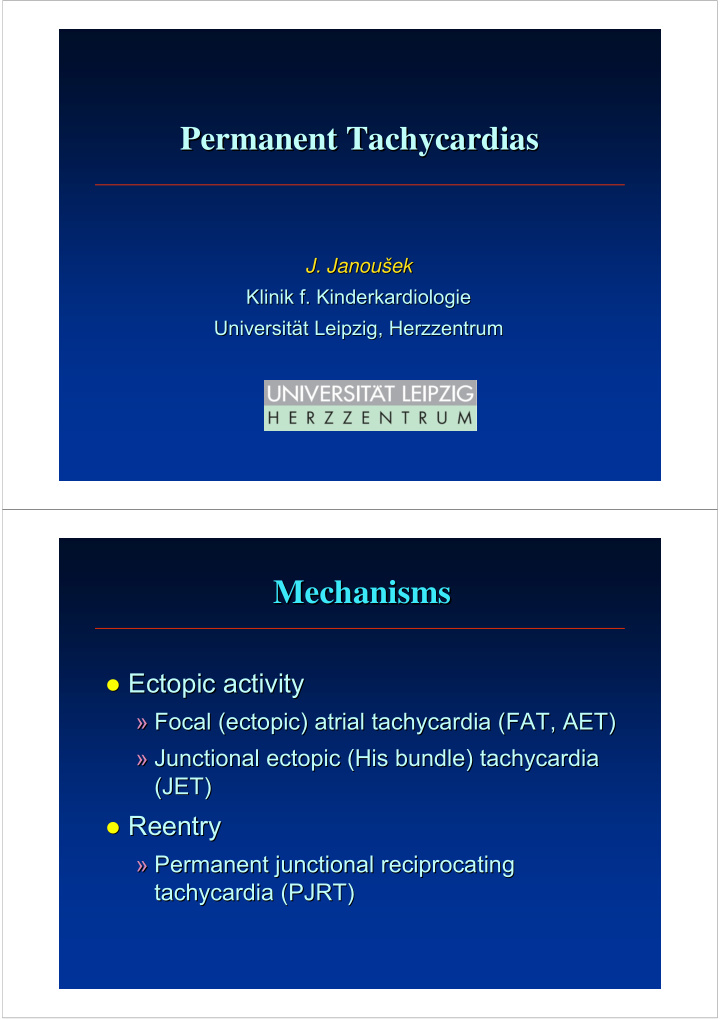



Permanent Tachyc cardi ardias as Permanent Tachy J J. . Janou Janouš šek ek Klinik f. Kinderkardiologie Klinik f. Kinderkardiologie Universitä ät Leipzig, Herzzentrum t Leipzig, Herzzentrum Universit Mechanisms echanisms M � Ectopic activity Ectopic activity � » Focal Focal (e (ectopic ctopic) ) atrial atrial tachycardia tachycardia (FAT (FAT, , AE AET) T) » » Junctional ectopic (His bundle) Junctional ectopic (His bundle) tachycardia tachycardia » (JET) (JET) � Reentry Reentry � » Permanent junctional reciprocating Permanent junctional reciprocating » tachycardia (PJRT) tachycardia (PJRT)
Rationale of therapeutic approach Rationale of therapeutic approach � Natural history Natural history � � Severity of symptoms Severity of symptoms � � Risk Risk of tachycardia of tachycardia- -induced induced � cardiomyopathy cardiomyopathy versus versus Benefits and risk isks s of drug therapy of drug therapy Benefits and r and catheter ablation and catheter ablation Indications for RF RF catheter ablation catheter ablation Indications for in childern: : Class Class I I in childern � Resuscitated cardiac arrest in WPW � Syncope in WPW » Min. preexc. RR <250 msec during AFib » AC ERP <250 msec � Incessant SVT with ventricular dysfunction Friedman RA et al., PACE 2002 NASPE Expert Consensus Conference
Indications for RF RF catheter ablation catheter ablation Indications for in childern: : Class Class II A II A in childern � Recurrent symptomatic SVT refractory to drug therapy, age >4 yrs � Cardiac surgery prohibiting further approach to arrhythmogenic substrate (TCPC) � Incessant SVT with normal ventricular function Friedman RA et al., PACE 2002 NASPE Expert Consensus Conference Focal ( (ectopic ectopic) ) atrial tachycardia atrial tachycardia Focal
AET originating from septal focus AET originating from septal focus Main features Main features � P wave of first beat identical to P wave of first beat identical to � subsequent beats subsequent beats � Warming Warming- -up and cooling up and cooling- -down down � phenomenon phenomenon � May have AV block during running May have AV block during running � tachycardia tachycardia � No induction by pacing No induction by pacing �
AET / adenosine AET / adenosine Before ablation EAT – heart rate profile After ablation
Tachycardia induced CMP Tachycardia induced CMP Prior to therapy 1 year after ablation Natural history and therapeutic response response Natural history and therapeutic � Tachycardia induced CMP Tachycardia induced CMP � » Higher risk with higher heart rates and Higher risk with higher heart rates and » permanent tachycardia permanent tachycardia � Spontaneous resolution Spontaneous resolution 1 1 � » <3 yrs.: 78 %, » <3 yrs.: 78 %, ≥ ≥ 3 yrs: 16 % (p<0.001) 3 yrs: 16 % (p<0.001) � Pharmacological control Pharmacological control 1 1 � » <3 yrs.: 91 %, <3 yrs.: 91 %, ≥ ≥ 3 yrs: 37 % (p<0.001) 3 yrs: 37 % (p<0.001) » � Recurrence possible! Recurrence possible! � 1 Salerno 1 Salerno JC JC et al., JACC 2004 et al., JACC 2004
AET from right upper pulm. vein AET from right upper pulm. vein Sinus r. Sinus r. AET AET AET from right upper pulm. vein AET from right upper pulm. vein RAO LAO
Junctional ectopic tachycardia ectopic tachycardia (JET) (JET) Junctional ECG ECG 1 s 1 s
Main features Main features � Congenital, adult and postoperative form Congenital, adult and postoperative form � � Congenital form Congenital form � » Family Family history (up to 55.6 %) history (up to 55.6 %) 1 1 » » » Progression into CAVB Progression into CAVB 2,6 2,6 » Spontaneous rate acceleration Spontaneous rate acceleration 1 1 » » » High incidence of heart High incidence of heart failure (up to 60 %) failure (up to 60 %) 1 1 » Therapy: Therapy: » – Propafenone Propafenone 3 3 , Amiodarone , Amiodarone 1 1 , Amiodarone+IC , Amiodarone+IC 4 4 – – Cave: digoxin – Cave: digoxin 1 1 , proarrhythmia , proarrhythmia 4 4 – Ablation – Ablation 5 5 � Adult form Adult form � » » Later in life, better Later in life, better tolerated, lower tolerated, lower HRs HRs 1 Villain E et al. Circulation 1990, 2 Henneveld H et al. Heart 1998, 3 Paul T et al. J Am Coll Cardiol 1992, 4 Sarubbi B et al. Heart 2002, 5 Fishberger SB et al. PACE 1998, 6 Dubin AM et al. HeartRhythm 2004 Permanent junctional reciprocating junctional reciprocating Permanent tachycardia (PJRT) (PJRT) tachycardia
Main features Main features � Posteroseptal pathway Posteroseptal pathway � � Retrograde conduction Retrograde conduction � only only � Decremental properties Decremental properties � � Incessant Incessant � � Tachycardia induced Tachycardia induced � CMP CMP Adapted using Mazgalev TN et al., Circulation 2001 Long RP, short PR ong RP, short PR L I V1 II V2 III V3 V4 aVR V5 aVL aVF V6 1 s 1 s
Diagnostic clue Diagnostic clue 300 360 360 180 200 220 PJRT – – multicenter multicenter study study PJRT � N = 85 N = 85 � � Age at diagnosis Age at diagnosis 0 0- -20 20 yrs yrs ( (median median 3 3 mo mo) ) � � Follow Follow- -up median up median 8.2 8.2 yrs yrs � � CHF 28 % CHF 28 % � » » resolved with medical Tx resolved with medical Tx in in all all � Success of medical Tx Success of medical Tx: 94 % : 94 % � » amio amiodarone darone/ /verapamil verapamil + digoxin + digoxin » � Spontaneous resolution: 22 % Spontaneous resolution: 22 % � � Death: 2 pts with persistent LV dysfunction Death: 2 pts with persistent LV dysfunction � Vaksmann G et al., Heart 2005
PJRT mapping and ablation PJRT mapping and ablation RF energy application Ventricular extrastimulus 354 ms 329 ms Retrograde block
Recommend
More recommend